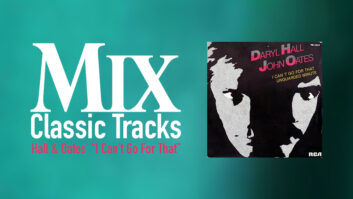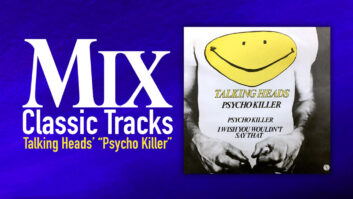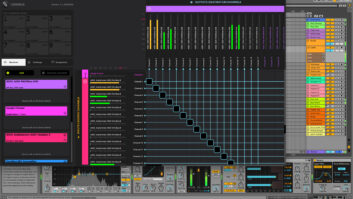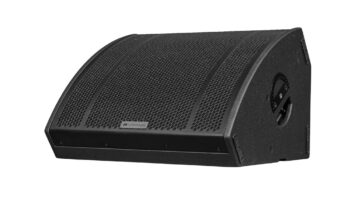Choice. When it comes to living my life and spending my time and money, choice is what I want. This month, I’m putting on my National Enquirer hat and stirring up a petite pot boiler.
But I’m getting ahead of myself…Having just returned from CES, where digital media trends of the future are trotted out in iMac colors, I was both horrified and amused by the emphasis on home automation and ubiquitous rich media delivery. Digital radio services that receive, store and play back only your favorite tunes and shows, for a low monthly fee; Internet access, in full color and stereo sound, in your new PT Cruiser while fighting commuter traffic. Although I can’t wait until liquid-crystal toilet paper arrives, I worry how all these delivery channels will or, worse, won’t work with each other. Therefore the word for the day is “Conformance,” to ensure that not only are distribution channels interoperable, but that they reproduce content in precisely the same way that a producer specifies.
Now, imagine a day when common appliances like your alarm system, ‘fridge and microwave have a connection to the ‘Net, in addition to their already existing embedded oS. That’s great for keeping the freezer stocked and the house secure. But, what about more complicated items like the DTV set-top boxes coming into the market next year? Intel, a founding member of the Advanced Television Enhancement Forum (ATVEF) consortium along with Microsoft, NBC and Disney, has begun datacasting into my home market from its Center for Datacasting Innovation in Santa Clara, Calif. “Gorsh, Dad, I clicked on that funky download graphic by accident, and now the TV won’t work!”
This month’s rant is about the now-familiar fight of open systems pitted against proprietary products. In this instance, the combatants are the ATVEF and the ATSC’s (Advanced Television Systems Committee) DTV Application Software Environment (DASE) group. Both are associations vying for control of a large consumer market. Both have a great deal at stake and envision tremendous returns, revenues for the former and interoperability for the latter, if they’re successful. And, caught in the middle is both the consumer and us folks, members of the production and support services industry. We already have to deal with the current range of non-standards. The practice of allowing corporations or trade organizations to sidestep basic interoperability to serve their profit projections isn’t something I applaud.
Sometimes proprietary products pose as open and egalitarian. Now, I’m no fan of the ATSC. Its demure handling of the DTV standard has pissed off both consumer electronics (CE) manufacturers and broadcasters alike. But, the ATSC’s take on interactive TV is, to my taste, a more workable approach than the ATVEF’s. CE manufacturers seem to agree.
The ATVEF wants to shape the standard to conform to its view of the world. The ATVEF proposal is based on extensions to JavaScript and HTML 4.0. As I see it, one of the key problems with this approach is Microsoft’s track record of diluting competitive technology by “extending” standards. This behavior doesn’t engender confidence, given its track record-especially as it envisions client applications, based on the Win32 API, that talk directly to a set-top box. APIs (or application programming interfaces) are software modules that abstract underlying mechanisms, making for portable, more easily created code.
According to an unnamed source quoted in EE Times, the ATVEF proposal is “so PC-centric that it will force consumer manufacturers to design their receivers either to look a lot like a lower-end PC or a WebTV set-top…It leaves us very little room to scale or differentiate our products…” or to have reliable television services that interoperate with any vendor’s gear.
So it’s interesting to note that a unified XHTML specification was just approved by the World Wide Web Consortium (W3C), the ‘Net’s standards body. XHTML merges XML, the Extensible Markup Language and Version 4 of HTML (HyperText Markup Language). Together, they control the standard exchange and display of information on the Web.
The ATSC-as a standards-setting body-envisions its role as a facilitator working for the creation of “a harmonized solution in the world across terrestrial and cable broadcast networks.” Mark Richer, executive director of the ATSC, rightly downplays my combative slant, characterizing the competition as simply the give and take of standards-making. He does concede that “DASE is a more comprehensive standard than ATVEF, with complete software and middleware.” That middleware consists of an Application Execution Engine, a Presentation Engine, APIs and other modules. The DASE-proposed specification relies heavily on the Java Media Framework and proposes a Java-based XHTML decoder in the TV receiver system. It wants to create a scalable, secure, oS-agnostic standard for both broadcasters and CE manufacturers.
Another hair ball is the use or abuse of the Java platform. Sun has been pig-headed about its insistence on extracting fees from licensees while proclaiming itself the shepherd of the standard. Yeah, right. All sides of the debate find Sun’s Java licensing policy unacceptable. Ah, but here come the Feds. Recently, a federal judge has ruled that Microsoft must ship products featuring the Java programming language that conform to standards set by their arch rival, Sun Microsystems. Though it’s too soon to tell at press time, this single event could validate not only the ATSC offering but stabilize the whole Java platform. We shall see.
As the marketplace naturally seeks equilibrium, both consumers and professionals increasingly suffer from technology overload. The transition to DTV will, for most of us, not be an easy one, and adding more complexity to our lives can’t make things better. Given that, if the DTV system is designed from the start to be extensible and interoperable, then at least we won’t have to worry about compatibility at home and at work…Stay informed. The ATSC can be reached at www.atsc.org/contact. html and you can contact ATVEF at www.atvef.com/contact.html.
There are two other movements that strengthen the unmolested Java platform and the DASE’s position. one is the European Multimedia Home Platform (MHP) for set-top boxes and the other is the Advanced Interactive Content (AIC) initiative. The AIC seeks “to integrate and harmonize VRML, MPEG-4, and Broadcast HTML (an XHTML subset),” creating an open specification using only existing technology. That is, with no extensions. If successful, they will have created a content-programming platform for a broadcast environment, delivered by either MPEG-2 or IP transport protocols.
Basically, MHP is a set of common APIs designed to create an oS-independent standard for Java-based, Digital Video Broadcast (DVB) interactive television. The main difference between DASE and MHP is that the European effort must address legacy systems and the US proposal does not. ATSC mentions that 70% of the Java APIs are common. So, commonality between the US and European systems could mean lower costs and ease of data interchange: a lofty goal. Thank the gods that there are companies with representatives in both the ATVEF and DASE camps and pray that efforts to harmonize the disparate desires of all parties is successful.
MP3.com Sues RIAAon February 8, MP3.com Inc. sued the Recording Industry Association of America (RIAA) and its president and CEo, Hilary Rosen, for defamation, trade libel, interference with prospective economic advantage and unfair business practices stemming from the RIAA’s recent lawsuit filed against MP3.com. The complaint, filed in San Diego Superior Court, alleges several causes of action for unfair business practices, including “increasingly aggressive tactics of the RIAA and its leadership,” said MP3.com chairman Michael Robertson. “We have recently learned that Hilary Rosen was speaking to equity analysts about the RIAA’s New York lawsuit three days before it was filed. While she was doing this, her lawyers were at MP3.com learning about our My.MP3.com technology. The next day I met with her in Washington to engage in an open discussion about business models for bridging our respective interests. Little did I know that she was more concerned about talking to equity analysts about our stock price.”
In a statement issued the same day, Rosen denounced the lawsuit: “This is a transparent attempt on the part of MP3.com to silence criticism of its infringing tactics…our record is clear in distinguishing legitimate uses of MP3 technology from piracy. The lawsuit against MP3.com has nothing to do with MP3 technology. It has to do with MP3.com, the company, taking music they don’t own and haven’t licensed to offer new services to make money for themselves…”







